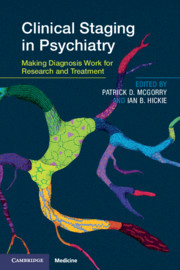Book contents
- Clinical Staging in Psychiatry
- Clinical Staging in Psychiatry
- Copyright page
- Contents
- Contributors
- Foreword
- Acknowledgements
- Section 1 Conceptual and Strategic Issues
- Section 2 Progress with Clinical Staging
- Chapter 5 The Utility of Clinical Staging in Youth Mental Health Settings
- Chapter 6 Neuroimaging and Staging
- Chapter 7 Staging of Cognition in Psychiatric Illness
- Chapter 8 Neuroinflammation and Staging
- Chapter 9 Bioactive and Inflammatory Markers in Emerging Psychotic Disorders
- Chapter 10 Electroencephalography and Staging
- Section 3 Novel Treatment Strategies
- Section 4 Novel Treatment Strategies
- Index
- Plate Section (PDF Only)
- References
Chapter 10 - Electroencephalography and Staging
from Section 2 - Progress with Clinical Staging
Published online by Cambridge University Press: 08 August 2019
- Clinical Staging in Psychiatry
- Clinical Staging in Psychiatry
- Copyright page
- Contents
- Contributors
- Foreword
- Acknowledgements
- Section 1 Conceptual and Strategic Issues
- Section 2 Progress with Clinical Staging
- Chapter 5 The Utility of Clinical Staging in Youth Mental Health Settings
- Chapter 6 Neuroimaging and Staging
- Chapter 7 Staging of Cognition in Psychiatric Illness
- Chapter 8 Neuroinflammation and Staging
- Chapter 9 Bioactive and Inflammatory Markers in Emerging Psychotic Disorders
- Chapter 10 Electroencephalography and Staging
- Section 3 Novel Treatment Strategies
- Section 4 Novel Treatment Strategies
- Index
- Plate Section (PDF Only)
- References
Summary
This chapter covers the staging evolution of the most important brain functioning impairments, as measured with electroencephalography (EEG), in psychosis spectrum and in severe mood disorders. The current state of the literature demonstrates that although these impairments have been extensively studied in all stages of schizophrenia, the results remain highly inconsistent in bipolar disorder and major depressive disorder, and almost nonexistent for the early stages of these illnesses. Indeed, it is currently impossible to draw any conclusion with regard to the state or trait character of any of the EEG impairments in both major depressive and bipolar disorders. As for psychosis, the most promising staging markers are the pitch mismatch negativity, as well as the P300 event-related potentials, as these components seem to deteriorate with increasing severity of the illness. Longitudinal studies will be necessary to follow the course of the EEG-measured impairments in ‘at-risk’ individuals who are later diagnosed with a severe mental illness. Furthermore, and most importantly, if some of these markers are going to be used as diagnostic tools in the establishment of the stage of a psychotic disorder, a quantifying parameter will need to be identified as well as normal and pathological ranges.
Keywords
- Type
- Chapter
- Information
- Clinical Staging in PsychiatryMaking Diagnosis Work for Research and Treatment, pp. 204 - 220Publisher: Cambridge University PressPrint publication year: 2019



